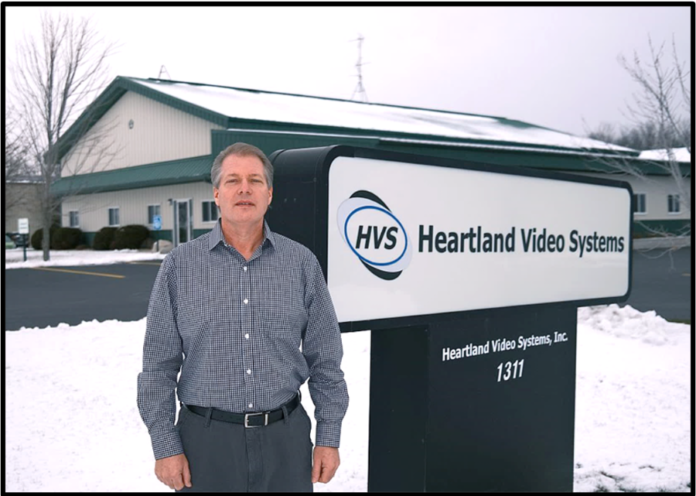The 2022 NAB Show and NAB Show New York are now in the history books. But, Heartland Video Systems is relishing in the value of “a unique exhibit” it organized at the Las Vegas affair that offered lessons on technology integration associated with the voluntary rollout of the NEXTGEN TV digital broadcast standard.
At the April event, Heartland’s exhibit booth showed how it successfully meshed the services of 13 ATSC 3.0 technology suppliers into three live ATSC 3.0 broadcast chains, offering a physical demonstration of ATSC 3.0 interoperability.
This was matched by a shift in interest among those visiting the Heartland exhibit toward how to make the ATSC 3.0 transition useful for both broadcasters and consumers, rather than about the basic implementation of physical ATSC 3.0 infrastructure, Heartland President Dennis Klas said. “They also wanted to know what the killer app would be that would bring more consumer engagement,” he remarked.
Klas had many conversations and follow-up interviews with key broadcast technology company leaders regarding the ATSC 3.0 integration demonstration.
Rohde and Schwarz’s National Account Manager for Broadcast, Graziano Casale, remarked, “Our discussions with customers have become more nuanced because ATSC 3.0 signals can be optimized for a wider variety of functions. This impacts how we help clients set up the RF part of their network. After we discuss the legacy transmitter and antenna, we switch to the technology needed to support business models they are pursuing. Should they be considering use of an SFN, LDM, MIMO, or multi subframe?”
Keyur Parikh, Vice President of Engineering at GatesAir, understands that the new consumer-facing opportunities with ATSC 3.0 are enabled by data. When a broadcast signal functions as a data stream, quality of signal becomes more important. “Integrating IP directly into the exciter has varying challenges,” Parikh says. “We had to mitigate impairments such as packet loss, jitter, and re-ordering. To mitigate them, we ensured that we supported a higher level of FEC and seamless switching to ensure we can handle packet losses. We also had to increase our upfront re-sequencing buffer to handle a higher order of out of order packets as well as increased jitter. Both were observed on several operational WAN networks.”
Some suppliers offered advice on dealing with ATSC 3.0 changes. Fred Ramsey, Director of Sales for North America at ATEME, commented, “SDI is a very defined and specific standard. Conversely, ‘IP’ can mean many different things. The key comes down to inter-connection, making sure that all high-speed I/O interfaces will be compatible with other elements of the plant infrastructure.”
Joonyoung Park, SVP and a fellow at DigiCAP, recommends learning about the physical layer of ATSC 3.0 early on. He said, “One completely new feature of ATSC 3.0 compared to ATSC 1.0 is the physical layer. From 8VSB to OFDM, adding PLP (Physical Layer Pipe), you can now set different modulation and coding, forward error correction, etc., for each PLP. Most of the vendors, if not all, offer this feature as a stand-alone subsystem called “Scheduler,” meaning a system that schedules spectrum resources. Scheduler adds great flexibility and efficiency to the use of the broadcast spectrum, and with it comes added complexity. We had to very carefully craft the system control UI to make the system setting and operation as painless as possible, but still a new concept requires user training.”
 Ralph Bachofen, Vice President of Sales and Marketing at Triveni Digital, advises that when an ATSC 3.0 system is being designed, system security needs a serious review. “ATSC 1.0 signals were rarely compromised, but ATSC 3.0 is designed for integration with IP systems, including the public internet. We recommend using a reliable protocol such as SRT while transporting over public internet. Use IT security, firewalls, and platform OS security. Secure remote access is key.”
Ralph Bachofen, Vice President of Sales and Marketing at Triveni Digital, advises that when an ATSC 3.0 system is being designed, system security needs a serious review. “ATSC 1.0 signals were rarely compromised, but ATSC 3.0 is designed for integration with IP systems, including the public internet. We recommend using a reliable protocol such as SRT while transporting over public internet. Use IT security, firewalls, and platform OS security. Secure remote access is key.”
With the shift to the ATSC 3.0 standard creating many opportunities and new technologies, system integrators like Heartland Video Systems, working with broadcast industry suppliers, can be looked upon with early insights into where technology is going and how best to manage it.
— With reporting by Josh Gordon, in Brooklyn, N.Y.





